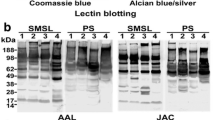Abstract
There is genetic polymorphism of the peroxidase of human saliva, but not of leukocytes. The phenotypes are determined by autosomal inheritance, the phenotype of fast mobility (SAPX 1) being determined by homozygosity for a recessive gene (SAPX 1) and the phenotypes of slow mobility (SAPX 2 and SAPX 3) being determined by two different genes, SAPX 2 and SAPX 3, with completely dominant expression at the same locus. The phenotypes are modified by varying degrees of endogenous proteolysis. The SAPX 2 and SAPX 3 types appear to be genetically controlled modifications of SAPX 1 rather than different primary gene products, because of their completely dominant inheritance, their larger molecular size compared to SAPX 1, and their dissociation with 2-mercaptoethanol to give SAPX 1. The acidic protein type Pa 1 is always found in association with SAPX 2, and an uncommon variant type Pa 2 is associated with SAPX 3. The most likely hypothesis is that the genes Pa 1 and Pa 2 produce products which modify the SAPX 1 type. When the Pa type is Pa 0, the SAPX phenotype is SAPX 1. Since 2-mercaptoethanol can dissociate the Pa 1 protein into a probable monomeric form, and can dissociate SAPX 2 and SAPX 3 to give SAPX 1, it is probable that Pa 1 and Pa 2 monomers complex with SAPX 1 through disulfide bonds to give SAPX 2 or SAPX 3 types. The frequencies of the genes determining the SAPX types are the same as those for Pa: SAPX 1 and Pa 0=0.787, SAPX 2 and Pa 1=0.208, SAPX 3 and Pa 2=0.005.
Similar content being viewed by others
References
Azen, E. A. (1972). Genetic polymorphism of basic proteins from parotid saliva. Science 176673.
Azen, E. A. (1973). Properties of salivary basic proteins showing polymorphism. Biochem. Genet. 969.
Azen, E. A., and Denniston, C. L. (1974). Genetic polymorphism of human salivary proline-rich proteins: Further genetic analysis. Biochem. Genet. 12109.
Azen, E. A., and Oppenheim, F. G. (1973). Genetic polymorphism of proline-rich human salivary proteins. Science 1801067.
Balakrishnan, C. R., and Ashton, G. C. (1974). Polymorphisms of human salivary proteins. Am. J. Hum. Genet. 26145.
Friedman, R. D., and Merritt, A. D. (1975). Partial purification and characterization of a polymorphic protein (Pa) in human parotid saliva. Am. J. Hum. Genet. 27304.
Friedman, R. D., Merritt, A. D., and Rivas, M. L. (1975). Genetic studies of human acidic salivary protein (Pa). Am. J. Hum. Genet. 27292.
Gothefors, L., and Marklund, S. (1975). Lactoperoxidase activity in human milk and in saliva of newborn infants. Infection Immun. 111210.
Hamon, C. B., and Klebanoff, S. J. (1973). A peroxidase mediated Streptococcus mitis dependent antimicrobial system in saliva. J. Exp. Med. 137438.
Hedrick, J. L., and Smith, A. J. (1968). Size and charge isomer separation and estimation of molecular weights of proteins by disc gel electrophoresis. Arch. Biochem. Biophys. 126155.
Iwamoto, Y., and Matsumura, T. (1966). Purification and characterization of the salivary antibacterial factor (S.A. factor). Arch. Oral Biol. 11667.
Iwamoto, Y., Inoue, M., Tsunemitsu, A., and Matsumura, T. (1967). Some properties of the salivary antibacterial factor (S.A. factor). Arch. Oral Biol. 121009.
Iwamoto, Y., Nakamura, R., Tsunemitsu, A., and Matsumura, T. (1968). The heterogeneity of human salivary peroxidase. Arch. Oral Biol. 131015.
Jordan, E. M., and Raymond, S. (1969). Gel electrophoresis: A new catalyst for acid systems. Anal. Biochem. 27205.
Karn, R. C., Shulkin, J. D., Merritt, A. D., and Newell, R. C. (1973). Evidence for post-transcriptional modification of human salivary amylase (Amyt) isozymes. Biochem. Genet. 10341.
Karn, R. C., Rosenblum, B. B., Ward, J. C., and Merritt, A. D. (1975). Genetic and posttranslational mechanisms determining human amylase isozyme heterogeneity. In Isozymes, Vol. IV: Genetics and Evolution, Academic Press, New York, p. 745.
Mason, D. K., and Chisholm, D. M. (1975). From Salivary Glands in Health and Disease, Saunders, Philadelphia, p. 42.
Merritt, A. D., Rivas, M. L., Bixler, D., and Newell, R. (1973a). Salivary and pancreatic amylase: Electrophoretic characterizations and genetic studies. Am. J. Hum. Genet. 25510.
Merritt, A. D., Lovrien, E. W., Rivas, M. L., and Conneally, P. M. (1973b). Human amylase loci: Genetic linkage with Duffy blood group locus and assignment to linkage group I. Am. J. Hum. Genet. 25523.
Morrison, M., and Steele, W. F. (1968). Lactoperoxidase, the peroxidase of the salivary gland. In Biology of the Mouth, Publication No. 89, American Association for the Advancement of Science, Washington, D.C., p. 89.
Slowey, R. R., Eidelman, S., and Klebanoff, S. J. (1968). Antibacterial activity of purified peroxidase from human parotid saliva. J. Bacteriol. 96575.
Teng, Y., Anderson, J. E., and Giblett, E. R. (1975). Cytidine deaminase: A new genetic polymorphism demonstrated in human granulocytes. Am. J. Hum. Genet. 27492.
Uriel, J. (1958). Colorimetric detection of human ceruloplasmin oxidase activity after electrophoresis on agar plates or after immunoelectrophoresis. Nature 181999.
Watkins, W. M. (1966). Blood-group substances. Science 152172.
Author information
Authors and Affiliations
Additional information
This study was supported by a grant from the National Institutes of Dental Research (2-RO1-DE-03658-11).
Rights and permissions
About this article
Cite this article
Azen, E.A. Salivary peroxidase (SAPX): Genetic modification and relationship to the proline-rich (Pr) and acidic (Pa) proteins. Biochem Genet 15, 9–29 (1977). https://doi.org/10.1007/BF00484545
Received:
Revised:
Issue Date:
DOI: https://doi.org/10.1007/BF00484545




